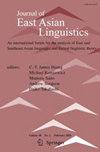成就与成就之差异的结构性解释:来自长沙湘汉语的证据
IF 0.5
3区 文学
0 LANGUAGE & LINGUISTICS
引用次数: 0
摘要
本文对长沙湘语的构面元素ka41进行了分析。有人认为,该元素在子句的内部方面结构中占据一个位置,介于较高的方面标记ta21和表示词法结果的较低元素之间(如wash clean中的clean)。基于它与各种动词类型的共现,我们将ka41视为成就标记:当它出现时,它会阻止所表示事件沿着多点刻度进行的任何阅读,只允许在事件的开始和终点重合的瞬时、两点刻度阅读。在句法分布的基础上,我们认为ka41所处的句法位置是内向域的一个中间向投影(Asp2P),它夹在专用于远程性的最低内向投影和信号完满性(或终点的实现)的最高内向投影之间。我们回顾了分析的意义,指出我们为长沙引入的中间内部方面投射(Asp2P)似乎是一个合适的句法位置,用于分析小组语法化的项目,通常被称为“相补语”。本文章由计算机程序翻译,如有差异,请以英文原文为准。
A structural account of the difference between achievements and accomplishments: evidence from Changsha Xiang Chinese
This paper offers an analysis of ka41, an aspectual element in Changsha Xiang Chinese. It is argued that this element occupies a position in the inner-aspectual structure of the clause, between the higher aspectual marker ta21 and the lower elements expressing a lexical result (like clean in wash clean). On the basis of its co-occurrence with various verb types, we treat ka41 as an achievement marker: when present, it blocks any reading in which the denoted event proceeds along a multi-point scale, allowing only the instantaneous, two-point scale reading in which the beginning and the endpoint of the event coincide. On the basis of its syntactic distribution we argue that the syntactic position ka41 occupies is an intermediate aspectual projection (Asp2P) in the inner aspect domain, which is sandwiched between the lowest inner aspectual projection dedicated to telicity and the highest one signaling perfectivity (or realization of the end point). We review the implications of the analysis for the aspectual domain of Mandarin clauses and point out that the intermediate inner aspectual projection (Asp2P) we introduce for Changsha appears to be a suitable syntactic position for the structural analysis of the small set of grammaticalized items generally known as “Phase complements” as well.
求助全文
通过发布文献求助,成功后即可免费获取论文全文。
去求助
来源期刊

Journal of East Asian Linguistics
Multiple-
CiteScore
0.90
自引率
0.00%
发文量
13
期刊介绍:
The study of East Asian languages, especially of Chinese, Japanese and Korean, has existed for a long time as a field, as demonstrated by the existence of programs in most institutions of higher learning and research that include these languages as a major component. Speakers of these three languages have shared a great deal of linguistic heritage during the development of their languages through cultural contacts, in addition to possible genealogical linkage. These languages accordingly possess various common features. Another important factor that ties them together as a field is that they have shared a common tradition of linguistic scholarship, a tradition that distinguishes itself from the study of western languages. Against this tradition, much recent work has approached these languages from a broader perspective beyond the area, considering them within contexts of general theoretical research, bringing new lights to old problems in the area and contributing to current issues in linguistic theory. But there continues to be good reason for scholars working in this approach to hold a special interest in each other''s work. Especially with the amount of most recent theoretical work on these languages, the field of theoretical East Asian linguistics has been fast growing. The purpose of the Journal of East Asian Linguistics is to provide a common forum for such scholarly activities, and to foster further growth that will allow the field to benefit more from linguistic theory of today, and enable the languages to play a more important role in shaping linguistic theory of tomorrow.
 求助内容:
求助内容: 应助结果提醒方式:
应助结果提醒方式:


